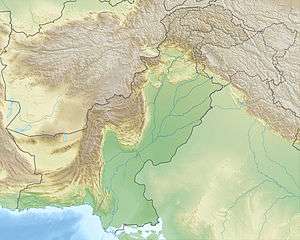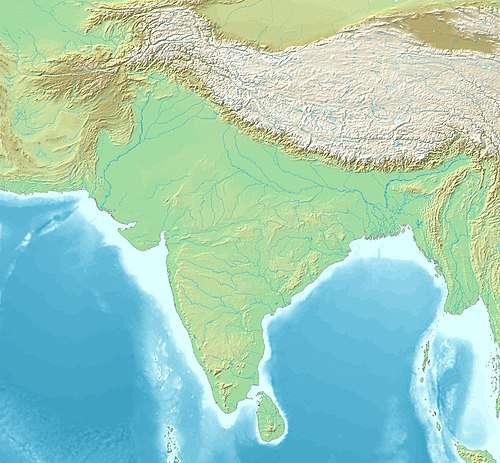Shahbaz Garhi
Shahbaz Garhi, or Shahbazgarhi, is a village and historic site located in Mardan District in the North West Frontier Province of Pakistan. It has an altitude of 293 metres (964 feet).[1]
 Shown within Pakistan | |
| Location | Pakistan |
|---|---|
| Region | Khyber Pakhtunkhwa |
| Coordinates | 34.235556°N 72.16°E |
It is about 12 km from Mardan city. It has mountains, green trees, open fields and a small river in the centre of the village.
In old times all these facilities made it attractive for the army and travelers to dig in their tents here, stay for few days and organize their further strategy. The historic Stones of Ashoka, and other sites like Mekha Sanda are worth visiting.
Location
Shahbaz Garhi is situated on the junction of three ancient routes;
- Kabul to Pushkalavati (modern Charsadda)
- Swat through Buner
- Taxila through Hund on the bank of Indus River.
Situated on the modern Mardan-Swabi Road, the town was once a thriving Buddhist city surrounded by monasteries and stupas.
Ancient rock edicts
Ashokan inscriptions
The town is the location of ancient rock-inscriptions[2] that are cut into two large rock boulders and written in the Kharosthi script.[3] They retain immense historical importance, as they appear to be the first examples of writing in South Asia.[3] They were constructed during the 3rd Century BC (272-231 BC), during the reign of Ashoka, the famous Mauryan emperor, inscribed in the Kharoshthi script.[3] The rock edicts were added to the UNESCO World Heritage Tentative List on 30 January 2004 in the Cultural category.[3][4]
The translation of the text is written on a board nearby the rocks. The sight is a famous tourist spot for people who are interested in history.
The town is the location of ancient rock-inscriptions[2] that are cut into two large rock boulders and written in the Kharosthi script.[3] They retain immense historical importance, as they appear to be the first examples of writing in South Asia.[3] They were constructed during the 3rd Century BC, during the reign of Ashoka, the famous Mauryan emperor.[3] The rock edicts were added to the UNESCO World Heritage Tentative List on 30 January 2004 in the Cultural category.[3]
- Edict No.12
- Edicts No.1 to No.11
- Edicts No.13 and No.14
 Protective housing
Protective housing A rubbing of two of the inscriptions.
A rubbing of two of the inscriptions.
References
- Location of Shahbazgarhi - Falling Rain Genomics
- NWFP - Imperial Gazetteer of India, v. 19, p. 149.
- Shahbazgarhi Rock Edicts - UNESCO
- Prof Ahmed Hasan Dani'Ashoka Rock Edicts at Shahbaz Garhi Mardan' in Journal of Archaeological Study, QAU, Islamabad, Pakistan, 1982
- Inscriptions of Asoka. New Edition by E. Hultzsch (in Sanskrit). 1925. pp. 56–57.
External links
| Wikimedia Commons has media related to Ashoka Major Rock Edict, Shahbazgarhi. |
| Edicts of Ashoka (Ruled 269–232 BCE) | |||||
| Regnal years of Ashoka |
Type of Edict (and location of the inscriptions) |
Geographical location | |||
| Year 8 | End of the Kalinga war and conversion to the "Dharma" |  Udegolam Nittur Brahmagiri Jatinga Rajula Mandagiri Yerragudi Sasaram Barabar Kandahar (Greek and Aramaic) Kandahar Khalsi Ai Khanoum (Greek city) | |||
| Year 10[1] | Minor Rock Edicts | Related events: Visit to the Bodhi tree in Bodh Gaya Construction of the Mahabodhi Temple and Diamond throne in Bodh Gaya Predication throughout India. Dissenssions in the Sangha Third Buddhist Council In Indian language: Sohgaura inscription Erection of the Pillars of Ashoka | |||
| Kandahar Bilingual Rock Inscription (in Greek and Aramaic, Kandahar) | |||||
| Minor Rock Edicts in Aramaic: Laghman Inscription, Taxila inscription | |||||
| Year 11 and later | Minor Rock Edicts (n°1, n°2 and n°3) (Panguraria, Maski, Palkigundu and Gavimath, Bahapur/Srinivaspuri, Bairat, Ahraura, Gujarra, Sasaram, Rajula Mandagiri, Yerragudi, Udegolam, Nittur, Brahmagiri, Siddapur, Jatinga-Rameshwara) | ||||
| Year 12 and later[1] | Barabar Caves inscriptions | Major Rock Edicts | |||
| Minor Pillar Edicts | Major Rock Edicts in Greek: Edicts n°12-13 (Kandahar) Major Rock Edicts in Indian language: Edicts No.1 ~ No.14 (in Kharoshthi script: Shahbazgarhi, Mansehra Edicts (in Brahmi script: Kalsi, Girnar, Sopara, Sannati, Yerragudi, Delhi Edicts) Major Rock Edicts 1-10, 14, Separate Edicts 1&2: (Dhauli, Jaugada) | ||||
| Schism Edict, Queen's Edict (Sarnath Sanchi Allahabad) Lumbini inscription, Nigali Sagar inscription | |||||
| Year 26, 27 and later[1] |
Major Pillar Edicts | ||||
| In Indian language: Major Pillar Edicts No.1 ~ No.7 (Allahabad pillar Delhi pillar Topra Kalan Rampurva Lauria Nandangarh Lauriya-Araraj Amaravati) Derived inscriptions in Aramaic, on rock: | |||||